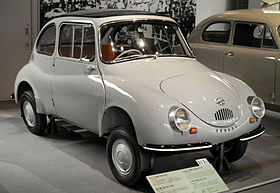Subaru 360
| Subaru 360 | |
|---|---|
 |
|
| Overview | |
| Manufacturer | Subaru |
| Also called | Subaru 450 K-10 (prototype) |
| Production | 1958–1971 |
| Assembly | Otakita Plant, Ōta, Gunma, Japan |
| Designer | Shinroku Momose |
| Body and chassis | |
| Class | Microcar |
| Body style | 2-door sedan 2-door convertible 3-door station wagon |
| Layout | RR layout |
| Related | Subaru Sambar |
| Powertrain | |
| Engine |
|
| Dimensions | |
| Wheelbase | 1,801 mm (70.9 in) |
| Length | 2,990 mm (117.7 in) |
| Width | 1,300 mm (51.2 in) |
| Height | 1,379 mm (54.3 in) |
| Curb weight | 410 kg (900 lb) |
| Chronology | |
| Predecessor | Subaru 1500 |
| Successor | Subaru R-2 |
The Subaru 360 is a rear-engined, two-door city car manufactured and marketed from 1958 to 1971 by Subaru. As the company's first automobile, production reached 392,000 over its 12-year model run.
Noted for its small overall size, 1,000 lb curb weight, monocoque construction, swing axle rear suspension, fiberglass roof panel, and rear-hinged doors, the inexpensive car was designed in response to the Japanese government's light car or Kei car regulations and its proposal for a larger "national car," both intended to help motorize the post WWII Japanese population. The 360's overall size and engine capacity complied with Japan's Kei car regulations.
Nicknamed the "ladybug" in Japan, and ultimately superseded by R-2, the 360 was one of Japan's most popular cars and was available in a single generation in two-door, station wagon, "convertible" (coupe with roll-back fabric roof) and sport model variants.10,000 were sold in the United States, imported by Malcolm Bricklin — advertised as "Cheap and Ugly."
The nameplate 360 derived from its tax-limited engine displacement: 356 cc.
The 360 featured an air-cooled, 2-stroke inline 2-cylinder 356 cc engine mounted transversely at the rear, and was introduced March 3, 1958.
As with the two-stroke Saab 93s and other small two-stroke gas engines, oil was needed to be pre-mixed with gas, with the fuel tank lid serving as a measuring cup. In 1964, the "Subarumatic" lubrication system provided automatic mixing via an under-hood reservoir.
Floor-mounted controls located between the driver and passenger seat included choke, heater and fuel cut-off — the latter to accommodate gravity fed fuel which obviated the need for a fuel pump. The initial production featured a full metal dash board and three-speed manual gearbox, while subsequent models featured a partially padded dash with an open glove compartment, pop-out rear quarter windows, split front bench seat, map pockets, a four-speed manual and optional three-speed-based 'Autoclutch' transmission — the latter which eliminated the clutch pedal and operated the clutch via an electromagnet.
Final assembly included wheel alignment, brake testing, chassis dynometer, headlight testing, and high-pressure water spray testing.
...
Wikipedia
